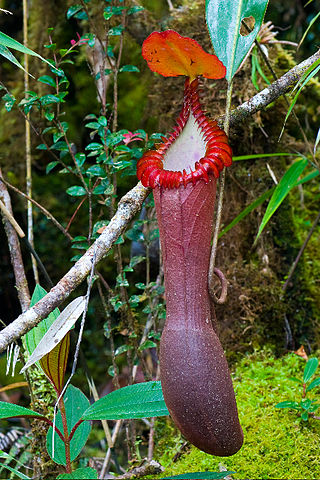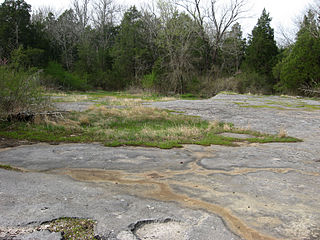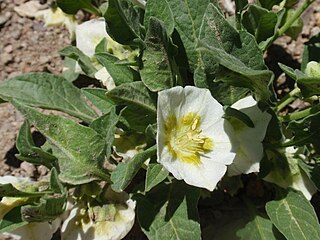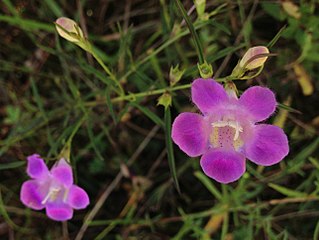
The Eastern Desert is the part of the Sahara desert that is located east of the Nile river. It spans 223,000 square kilometres (86,000 sq mi) of North-Eastern Africa and is bordered by the Nile river to the west and the Red Sea and Gulf of Suez to the east. It extends through Egypt, Eritrea, Sudan and Ethiopia. The Eastern Desert is also known as the Red Sea Hills. The Desert consists of a mountain range which runs parallel to the coast, wide sedimentary plateaus extending from either side of the mountains and the Red Sea coast. The rainfall, climate, vegetation and animal life sustained in the desert varies between these different regions.The Desert has been a mining site for building materials, and precious and semi-precious metals throughout history. It has historically contained many trade routes leading to and from the Red Sea, including the Suez Canal.

Nepenthes villosa, or the villose pitcher-plant, is a tropical pitcher plant endemic to Mount Kinabalu and neighbouring Mount Tambuyukon in northeastern Borneo. It grows at higher elevations than any other Bornean Nepenthes species, occurring at elevations of over 3,200 m (10,500 ft). Nepenthes villosa is characterised by its highly developed and intricate peristome, which distinguishes it from the closely related N. edwardsiana and N. macrophylla.

Nepenthes edwardsiana, or the splendid pitcher-plant, is a carnivorous tropical pitcher plant endemic to Mount Kinabalu and neighbouring Mount Tambuyukon in Sabah, Malaysian Borneo. It is considered one of the most spectacular of all Nepenthes, producing some of the largest pitchers and the most highly developed peristome ribs of any species in the genus.

Nepenthes macrophylla, the large-leaved pitcher-plant, is a tropical pitcher plant known only from a very restrictive elevation on Mount Trusmadi in Sabah, Malaysian Borneo.

Marai Parai or Marei Parei is a plateau on the northwestern side of Mount Kinabalu, in Malaysia. The mountain can be climbed from this side, although few parties attempt this route. The first recorded ascent of Mount Kinabalu via Marai Parai was done in 1987.

A calcareous glade is a type of ecological community that is found in the central Eastern United States. Calcareous glades occur where bedrock such as limestone occurs near or at the surface, and have very shallow and little soil development. Due to the shallow soil and the extreme conditions created by it, trees are often unable to grow in the glades. This creates a habitat that is usually sunny, dry, and hot. Calcareous glade vegetation is more similar to that of a desert habitat than a grassland, being dominated by small spring annuals with occasional geophytic or succulent perennials.

Nepenthes × harryana is the natural hybrid between N. edwardsiana and N. villosa. Its two parent species are very closely related and so N. × harryana, which is intermediate in form, may be difficult to distinguish from either of them.

Chamaesaracha is a genus of perennial herbs in the nightshade family which are known commonly as five eyes. There are around nine species of five eyes, and they are native to the southwestern and western United States and parts of Mexico. These are hairy plants growing low to the ground and covered in crinkly dull green leaves. The flowers are star-shaped to wheel-shaped and their dried remnants can be found around the fruits, which are spherical berries filled with flat, kidney-shaped seeds.

Agalinis is a genus of about 70 species in North, Central, and South America that until recently was aligned with members of the family Scrophulariaceae. As a result of numerous molecular phylogenetic studies based on various chloroplast DNA (cpDNA) loci, it was shown to be more closely related to members of the Orobanchaceae. Agalinis species are hemiparasitic, which is a character that in part describes the Orobanchaceae.

Agalinis acuta is an annual hemiparasitic plant native to Maryland, Massachusetts, Rhode Island, Connecticut, and Long Island, New York. Common names include sandplain gerardia and sandplain false foxglove. It is one of about 70 species that comprise genus Agalinis. It currently resides within the family Orobanchaceae, but historically was aligned with members of the Scrophulariaceae. This was one of several re-alignments that were the consequence of the disintegration of the Scrophulariaceae as the result of conclusions based on molecular phylogeny data from the chloroplast genome. While historically regarded as a separate species, molecular phylogenetic data indicates that Agalinis acuta should be consolidated as part of the species Agalinis decemloba.

Agalinis aspera, the rough agalinis, rough false foxglove, or tall false foxglove, is a non-poisonous plant of the genus Agalinis, habitating in the dry prairies. It can grow to be about eight to twenty-four inches tall. When the flowers bloom, the colors vary between purple and pink.

Agalinis auriculata is a species of flowering plant in the family Orobanchaceae known as earleaf false foxglove, auriculate false foxglove, and earleaf gerardia. It is endemic to the United States, where it occurs from New Jersey west to Minnesota and throughout most southern states.

Agalinis skinneriana is a species of flowering plant in the family Orobanchaceae known by the common names Skinner's gerardia, Skinner's false foxglove and pale false foxglove. It is native to North America, where it occurs in Ontario south to Missouri and Louisiana.

Agalinis paupercula, commonly known as the smallflower false foxglove, is a hemiparasitic annual plant native to the eastern parts of the United States and Canada. Found in open, moist areas, its purple flowers are borne on a 30-to-70-centimeter stem, and bloom in August and September. The species has often been treated as a variety of Agalinis purpurea, the purple false foxglove, and preliminary genetic evidence suggests that the two are, in fact, a single species.

Agalinis purpurea is an annual forb native to the eastern United States and Canada, which produces purple flowers in late summer or early fall.

Agalinis tenuifolia, known by the common names common gerardia, slender false foxglove or common false foxglove, is an annual forb native to the eastern and southwestern United States, and Canada, which produces purple flowers in late summer or early fall.

Agalinis gattingeri, the roundstem false foxglove, is an annual hemiparasitic forb measuring between 10.5 and 60.5 cm in height.

Agalinis heterophylla is a species of flowering plant in the family Orobanchaceae known as prairie false foxglove. It is found in northern Mexico (Tamaulipas) and the southeastern and central United States.

Anemone edwardsiana is a species of perennial wildflower in the buttercup family Ranunculaceae, with the common name Edwards Plateau Anemone. It is found on the Edwards Plateau in Texas.


















